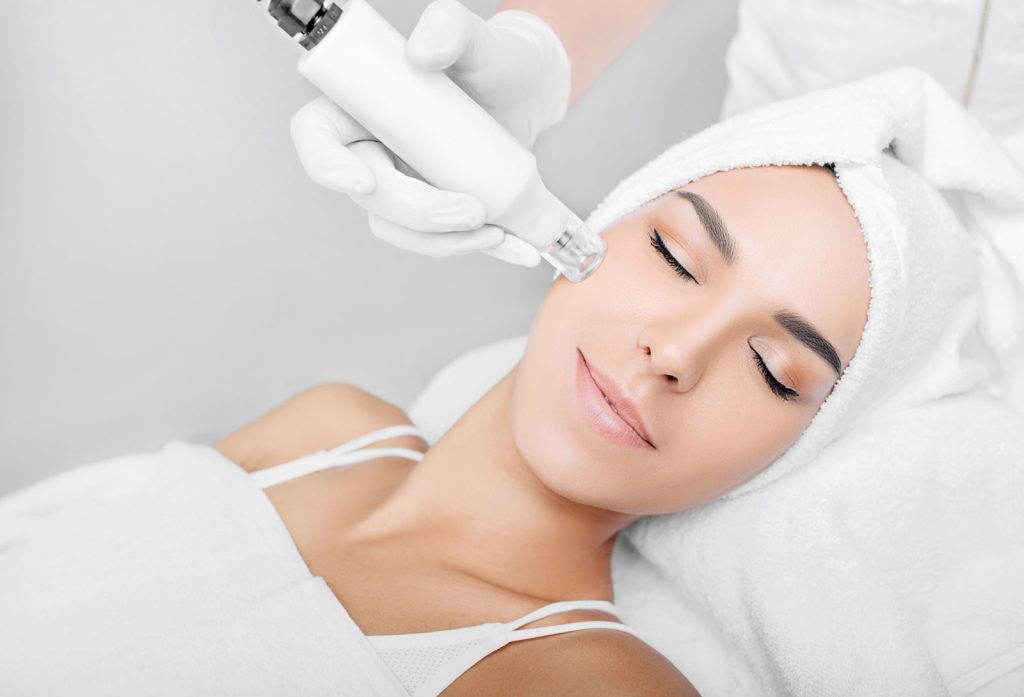Plasma gas skin tightening is a cutting-edge treatment gaining popularity for its effectiveness. This non-invasive procedure uses plasma energy to stimulate collagen and elastin production. It targets various areas, including the face, neck, and even delicate regions like around the eyes. The technology has roots in dermatological advancements that date back several decades. Today, it offers a modern solution for those seeking tighter, youthful skin without surgery. Patients appreciate its quick recovery time and minimal discomfort. Understanding suitable areas for treatment can help you make informed decisions about enhancing your appearance. Dive into the specifics of this innovative plasma treatment method and discover how plasma surgery can benefit you, including plasma pen skin tightening.
Key Takeaways
-
Plasma gas skin tightening is effective for areas like the face, neck, and décolletage, helping to improve skin elasticity and reduce wrinkles.
-
Understanding how the treatment works can help you feel more confident; it uses plasma energy to stimulate collagen production.
-
Pain levels are generally low, but individual experiences may vary; discussing comfort options with your provider is essential.
-
Proper aftercare is crucial for recovery; follow your provider’s instructions to ensure the best results after treatment.
-
Expect noticeable improvements in skin tightness and texture within weeks, but full results may take several months to appear.
-
Ideal candidates are those with mild to moderate skin laxity; consult with a professional to see if this treatment suits your needs.
Understanding Plasma Skin Tightening
Definition
Plasma skin tightening is a non-surgical cosmetic procedure. It uses a device called a plasma pen. This pen creates small, controlled bursts of energy. The energy heats the skin’s surface and stimulates collagen production.
The treatment targets areas with unwanted wrinkles and sagging skin. It works by causing micro-injuries to the skin. These injuries promote natural healing. As a result, the skin tightens and becomes firmer.
Purpose
The main purpose of plasma skin tightening is to reduce wrinkles. Many people seek this treatment for its effectiveness. It helps enhance skin retraction and improve overall appearance.
Patients often choose this method over traditional surgical options. Surgery can involve longer recovery times and more risks. Plasma skin tightening offers a safer alternative with quicker results.
Popularity
This treatment has gained popularity in recent years. Many individuals appreciate the minimal downtime required. Most can return to daily activities shortly after treatment.
Results from plasma pen skin tightening typically appear within a few days and improve over time. Patients often report feeling more confident after their sessions. They enjoy smoother, tighter skin without extensive procedures.
Suitable Areas
Plasma pen skin tightening can be performed on various areas of the body. Commonly treated areas include:
-
Face
-
Neck
-
Abdomen
-
Arms
-
Thighs
Each area responds well to the treatment. The procedure can address specific concerns like crow’s feet or jowls on the face.
Effectiveness
Many studies support the effectiveness of renuvion skin tightening as well. Results show significant improvements in skin texture and elasticity.
Patients often see a marked reduction in wrinkles after just one session. Multiple sessions may enhance results further, depending on individual needs.
Considerations
Not everyone is a candidate for this procedure. Individuals with certain medical conditions should consult with a professional first.
Potential side effects may include redness or swelling at the treatment site. These effects usually subside quickly.
How Plasma Skin Tightening Works
Micro-Injuries
Plasma skin tightening uses plasma energy to create micro-injuries in the skin. This process involves a plasma pen device that generates an electrical arc. The arc interacts with the skin’s surface, producing tiny dots that resemble a series of pinpricks. These micro-injuries are crucial for stimulating the body’s natural healing response.
The creation of these injuries triggers an inflammatory response. As a result, the body starts to repair itself. This leads to increased blood flow and the activation of skin cells. Over time, this process helps in rejuvenating the skin.
Collagen Production
Fibroblast plasma skin tightening stimulates collagen production. Collagen is a vital protein that provides structure and elasticity to the skin. The micro-injuries signal fibroblasts, which are cells that produce collagen, to start working harder.
As collagen levels rise, the skin begins to tighten and firm up. This improvement can be seen within a few weeks after treatment. Full results may take several months as collagen continues to rebuild. Many patients report smoother and more youthful-looking skin following their sessions.

Precision Targeting
The precision of the plasma pen device allows for targeted treatment areas. This means practitioners can focus on specific regions without affecting surrounding tissues. For example, delicate areas around the eyes or mouth can be treated effectively.
This precision minimizes damage to healthy skin and reduces recovery time. Patients often experience less swelling and redness compared to traditional surgical methods. Plasma treatments can be customized based on individual needs, ensuring optimal results.
Suitable Areas for Treatment
Common areas for plasma fibroblast therapy include:
-
Face: Treats wrinkles and sagging skin.
-
Neck: Reduces crepey skin appearance.
-
Eyes: Tightens eyelids and diminishes crow’s feet.
-
Abdomen: Helps with loose skin post-pregnancy or weight loss.
Each area benefits from the unique properties of plasma energy. The non-invasive nature of plasma pen treatment appeals to many seeking alternatives to surgical skin rejuvenation.
Recovery Process
Recovery from plasma pen treatment varies by individual but is generally quick. Most patients experience some redness similar to a mild sunburn right after treatment. This usually subsides within a few days.
Patients should keep treated areas clean and moisturized during healing. Sun protection is crucial as well, since new skin can be sensitive. Following these guidelines helps achieve the best results from the procedure.
Pain Level and Comfort
Discomfort Levels
Patients may experience mild discomfort during the plasma gas skin tightening procedure. The sensation can vary from person to person. Some describe it as a light prickling feeling, while others may feel a slight stinging. This discomfort is usually temporary and subsides soon after treatment.
Topical Anesthetics
To minimize pain, clinics often use topical anesthetics before starting the procedure. These creams numb the skin and help reduce sensitivity in the treatment area. Applying the anesthetic typically occurs about 30 minutes before the procedure. This allows time for the medication to take effect. Most patients find that this preparation makes a significant difference in their comfort levels.
Treatment Tolerance
Most patients find the treatment tolerable and quick. The entire process usually lasts around 30 minutes to an hour, depending on the areas being treated. Many patients report that they can resume normal activities shortly after the procedure.
Aftercare Comfort
Post-treatment care is important for maintaining comfort. Patients might experience some redness or swelling, similar to a mild sunburn. These effects are generally temporary and resolve within a few days. Doctors often recommend applying soothing creams or ice packs to ease any discomfort.
Individual Experiences
Individual experiences with pain can vary widely. Some people may have a higher tolerance for discomfort, while others may be more sensitive. Talking openly with healthcare providers about pain expectations can help manage concerns before the procedure begins.
Summary of Pain Management
In summary, plasma gas skin tightening involves some level of discomfort, but it is manageable. The use of topical anesthetics significantly reduces pain during treatment. Most patients find the overall experience tolerable and quick, allowing them to enjoy the benefits of skin tightening without prolonged discomfort.
Suitable Treatment Areas
Eyelids
Eyelids are a common area for skin treatments. They often show signs of aging first. This can lead to drooping skin and fine lines. Plasma gas skin tightening helps rejuvenate this delicate area. It tightens the skin and reduces wrinkles. Patients notice a significant improvement in their appearance.
Crow’s Feet
Crow’s feet are another target for treatment. These fine lines form around the eyes due to smiling and squinting. Plasma gas therapy effectively addresses these wrinkles. The procedure stimulates collagen production. This promotes healing skin and enhances overall texture.
Forehead
The forehead is also suitable for fibroblast treatments. Horizontal lines often develop here over time. These can make a person look older or tired. Plasma gas procedures can smooth these lines, creating a more youthful look. Many patients report high satisfaction after treatment.
Neck
The neck is an important area that often gets overlooked. It can show signs of aging just like the face. Skin may sag or become loose over time. Fibroblast therapy works well on the neck, tightening the skin effectively. This area responds positively to plasma gas treatments.
Décolleté
The décolleté region deserves attention too. This area includes the chest and upper body, which can also show age signs. Skin resurfacing techniques help improve its appearance. Treatments reduce wrinkles and enhance skin tone, making it look healthier.
Versatility of Treatment
The versatility of plasma gas skin tightening is notable. It addresses various facial lines and areas effectively. Patients can choose multiple regions for treatment in one session. This saves time and provides comprehensive results.
Healing Process
After undergoing fibroblast therapy, the healing process begins immediately. The treated areas may appear red but typically heal within a few days. Most patients experience minimal downtime, allowing them to resume daily activities quickly.
Long-lasting Results
Results from plasma gas treatments can last for months or even years. Maintenance sessions may be necessary to keep up with changes in the skin over time. Regular follow-ups ensure continued effectiveness of the treatment.
Aftercare and Recovery
Healing Process
Following plasma gas skin tightening, proper aftercare is essential for optimal healing. The skin undergoes a recovery phase that can last several days. During this time, the treated areas may appear red or swollen. This is normal and should subside gradually.
Patients must keep the skin clean and moisturized. Using gentle cleansers helps avoid irritation. Applying a suitable moisturizer aids in hydration and promotes healing. Following these steps ensures that the skin recovers effectively.
Sun Protection
Sun protection plays a crucial role in the recovery process. After treatment, the skin becomes more sensitive to sunlight. Direct exposure can lead to further damage or pigmentation issues. Therefore, wearing sunscreen with a high SPF is necessary.
Patients should apply sunscreen daily, even on cloudy days. Protective clothing and hats can also shield the skin from UV rays. Taking these precautions prevents complications and supports long-term results.
Dark Spots
Temporary dark spots may appear after treatment. These spots are part of the natural healing process. They occur as the skin sheds damaged cells and regenerates new ones. While they may seem concerning, they usually fade within a few weeks.
It’s important not to pick at or scratch these spots. Doing so can lead to scarring or infection. Instead, patients should allow their skin to heal naturally. Keeping the area clean and moisturized will aid in this process.
Consultation Importance
Consultation before the procedure is vital for understanding aftercare needs. A professional can provide personalized instructions based on individual skin types and concerns. This guidance helps set realistic expectations for recovery.
Patients should ask questions during consultations to clarify any uncertainties about aftercare. Understanding what to expect post-treatment enhances satisfaction with results.
Aging and Sagging Skin
Plasma gas skin tightening targets signs of aging and sagging skin effectively. The procedure stimulates collagen production, improving skin elasticity over time. However, maintaining results requires commitment to aftercare.
Following recommended practices helps prolong effects and keeps skin looking youthful longer. Regular follow-ups with a skincare professional can also help monitor progress.
Expected Results
Immediate Effects
Results from plasma gas skin tightening can be seen right after the procedure. Patients often notice immediate skin tightening effects. This happens because the energy from the plasma causes sublimation in the skin layers. The heat stimulates the skin, promoting an instant lift.
The skin may appear slightly red or swollen right after treatment. This is a normal reaction and should subside within a few days. The immediate tightening effect can boost confidence as patients see changes quickly.
Peak Results
Peak results become visible around 6-8 weeks after treatment. Collagen production and fibroblast activity increase during this period. These processes are essential for long-lasting skin improvements. The body continues to heal and regenerate, enhancing the final outcome.
Patients will see firmer, smoother skin at this stage. The full benefits of the procedure manifest as time passes. Regular follow-ups can help assess progress and ensure optimal results.
Individual Variations
Results vary widely based on individual skin conditions and lifestyle factors. Age plays a significant role in how well the skin responds to treatment. Younger individuals may experience faster healing and better outcomes compared to older patients.
Lifestyle choices also impact results. Factors such as smoking, sun exposure, and diet can affect skin quality. Individuals who maintain healthy habits may see improved results.
e patients may require multiple sessions to achieve desired effects. Each body reacts differently to the energy used in the procedure. Consulting with a qualified professional helps set realistic expectations.
Risks and Considerations
While plasma gas skin tightening is generally safe, there are some risks involved. Possible side effects include temporary redness, swelling, or discomfort. These symptoms usually resolve within days.
Understanding these risks is crucial before undergoing treatment. A thorough consultation allows patients to discuss concerns and pre-existing conditions that might affect results.
Ideal Candidates
Fitzpatrick Types
Prime candidates for plasma gas skin tightening typically fall under Fitzpatrick skin types I to III. These skin types are characterized by lighter skin tones that respond well to this treatment. Type I includes those who are very fair and often burn easily, while Type II individuals have fair skin that can tan minimally. Type III includes those with medium skin tones who tan more easily but may still experience some burning.
Individuals with these skin types generally see better outcomes from the procedure. The treatment works effectively on lighter skin because it minimizes the risk of hyperpigmentation. This is crucial since darker skin tones can react differently to the energy delivered during the procedure.
Risks for Darker Skin
People with darker skin tones, specifically Fitzpatrick types IV and above, should exercise caution. The risks associated with plasma gas skin tightening increase significantly for these individuals. They face a higher chance of developing post-inflammatory hyperpigmentation after the treatment. This could lead to uneven skin tone or dark patches that may last for months.
The energy levels used in the treatment can cause excessive heat, resulting in burns or discoloration in darker skin types. Therefore, it’s essential to consider these factors before proceeding with any treatment.
Pre-Treatment Consultation
A pre-treatment consultation is highly recommended for all candidates. During this meeting, a qualified practitioner evaluates the individual’s skin type and overall suitability for plasma gas skin tightening. This assessment helps identify any potential risks and ensures safety during the procedure.
Practitioners will discuss medical history and any previous skin treatments. They may also perform a patch test to see how the skin reacts to the energy used in plasma gas tightening. This step is vital in determining whether a person is a suitable candidate for this specific treatment.
Treatment Cost
Cost Variations
Costs for plasma treatments can vary widely. Factors such as the treatment area and the clinic’s location play a significant role. For instance, larger treatment areas like the abdomen may cost more than smaller areas like the neck. Urban clinics often charge higher prices due to increased overhead costs.
Patients should expect to pay between $500 to $3,000 per session. The average price for popular areas like the face or neck typically falls around $1,000. This range reflects the complexity of the procedure and the expertise required.
Multiple Sessions
Many individuals require multiple sessions to achieve desired results. Each session adds to the total cost. Some patients might need up to five treatments for optimal outcomes. This means budgeting for a series of sessions is essential.
For example, if each session costs $1,000 and a patient needs four sessions, the total expense would reach $4,000. Understanding this upfront allows patients to plan their finances better.
Package Deals
Patients should explore package deals offered by clinics. Many facilities provide discounts for purchasing multiple sessions at once. These packages can significantly reduce overall expenses.
e clinics offer financing options. Payment plans allow patients to spread costs over time. This makes treatments more accessible for those concerned about budget constraints.
Additional Costs
Consultation fees may also apply before beginning treatment. Initial assessments help determine suitability and specific needs. Patients should ask about these fees when contacting clinics.
Post-treatment care products might be recommended as well. These products can enhance results but add to overall expenses. It’s wise to discuss these potential additional costs during consultations.
Insurance Considerations
Insurance coverage for plasma treatments varies. Most insurance plans do not cover cosmetic procedures. Patients should verify their policy details for any exceptions.
Discussing financial concerns with clinic staff is beneficial. They can provide clarity on what costs to expect and help navigate insurance questions.
Final Remarks
Plasma gas skin tightening is a game-changer for your beauty routine. You’ve learned how it works, the areas it suits best, and what to expect during recovery. This treatment offers effective results with minimal discomfort, making it an appealing option for many.
If you’re considering this innovative procedure, consult a qualified professional to discuss your goals. They can help you determine if plasma skin tightening is right for you. Don’t wait to enhance your look—take the first step toward firmer, youthful skin today!
Frequently Asked Questions
What is plasma gas skin tightening?
Plasma gas skin tightening is a non-invasive treatment that uses plasma energy to stimulate collagen production. It helps tighten and rejuvenate the skin, improving its overall appearance.
How long does the treatment take?
Each session typically lasts between 30 minutes to an hour, depending on the area being treated. This makes it a convenient option for busy individuals seeking effective skin rejuvenation.
Are the results permanent?
While results can last for several months to years, they are not permanent. Regular maintenance treatments may be necessary to sustain optimal skin tightness and appearance over time.
Is plasma skin tightening safe?
Yes, plasma skin tightening is considered safe when performed by a qualified professional. Side effects are minimal and usually temporary, such as redness or swelling at the treatment site.
How many sessions are needed for optimal results?
Most patients require 1 to 3 sessions for optimal results. The exact number depends on individual skin conditions and desired outcomes, which will be assessed during your consultation.
Can anyone undergo this treatment?
While many people are suitable candidates, those with certain skin conditions or health issues may not be ideal. A consultation with a qualified practitioner will help determine if it’s right for you.
What areas can be treated with plasma skin tightening?
Suitable areas include the face, neck, abdomen, arms, and thighs. This versatile treatment targets sagging skin and fine lines in various regions effectively.





